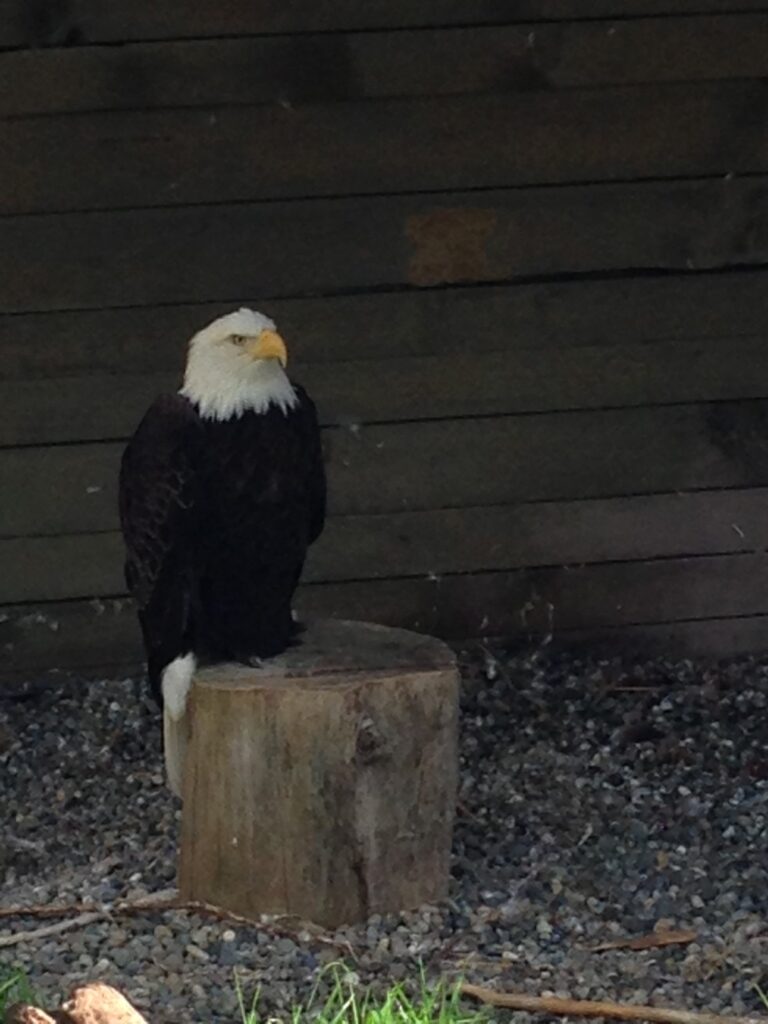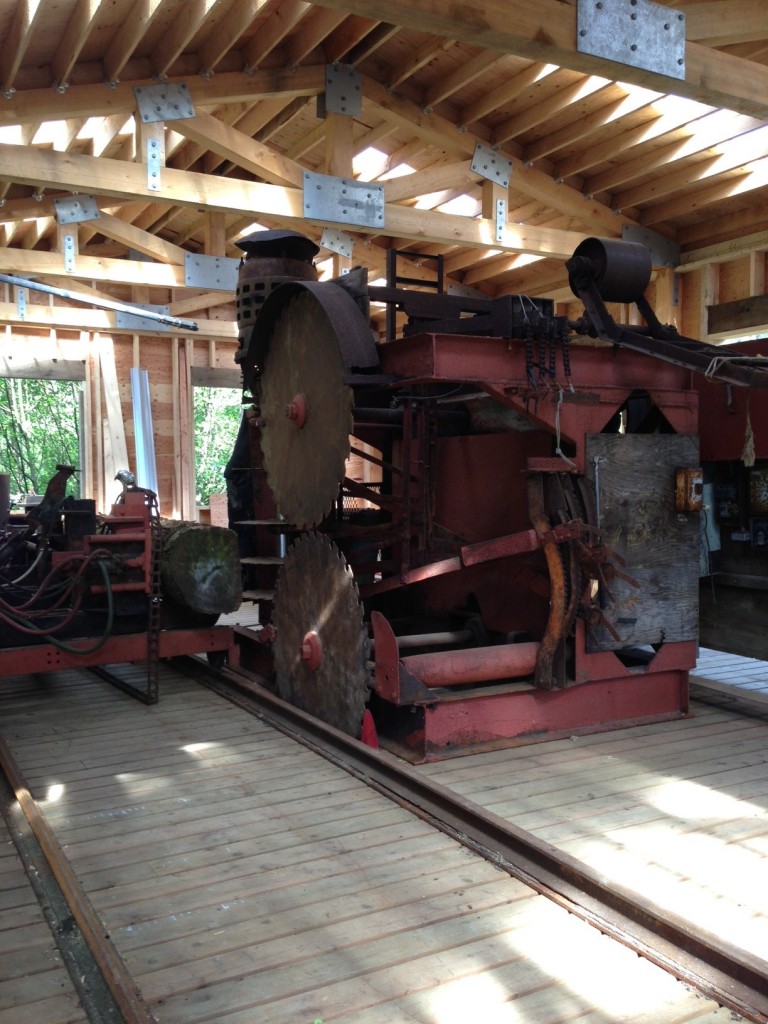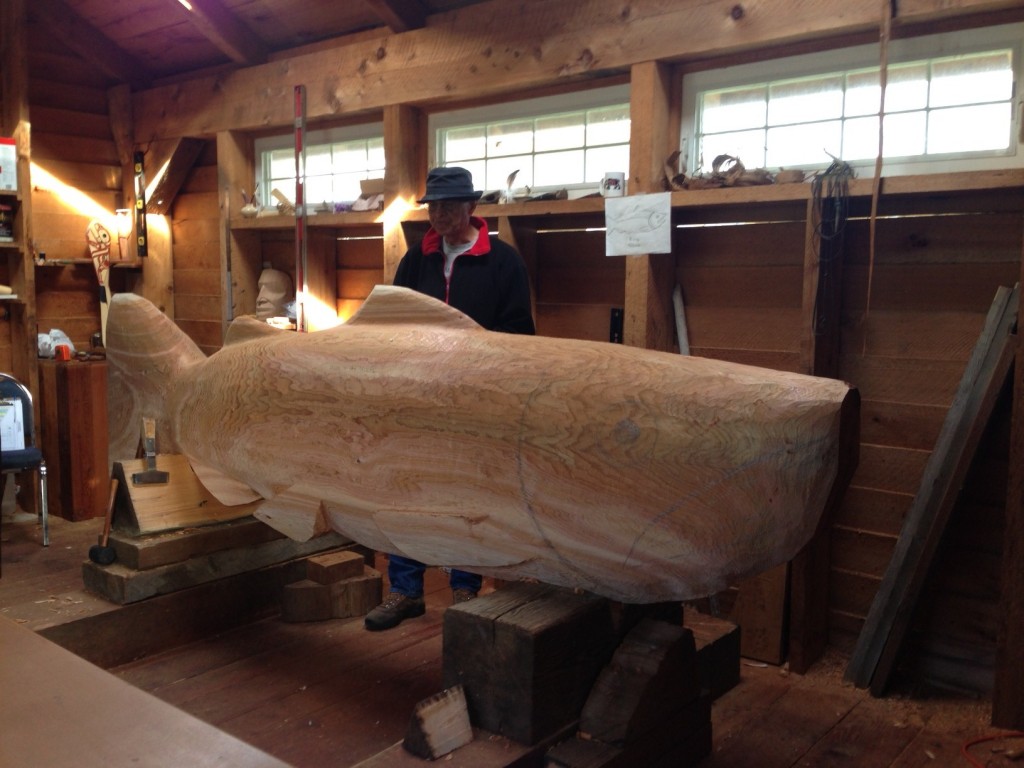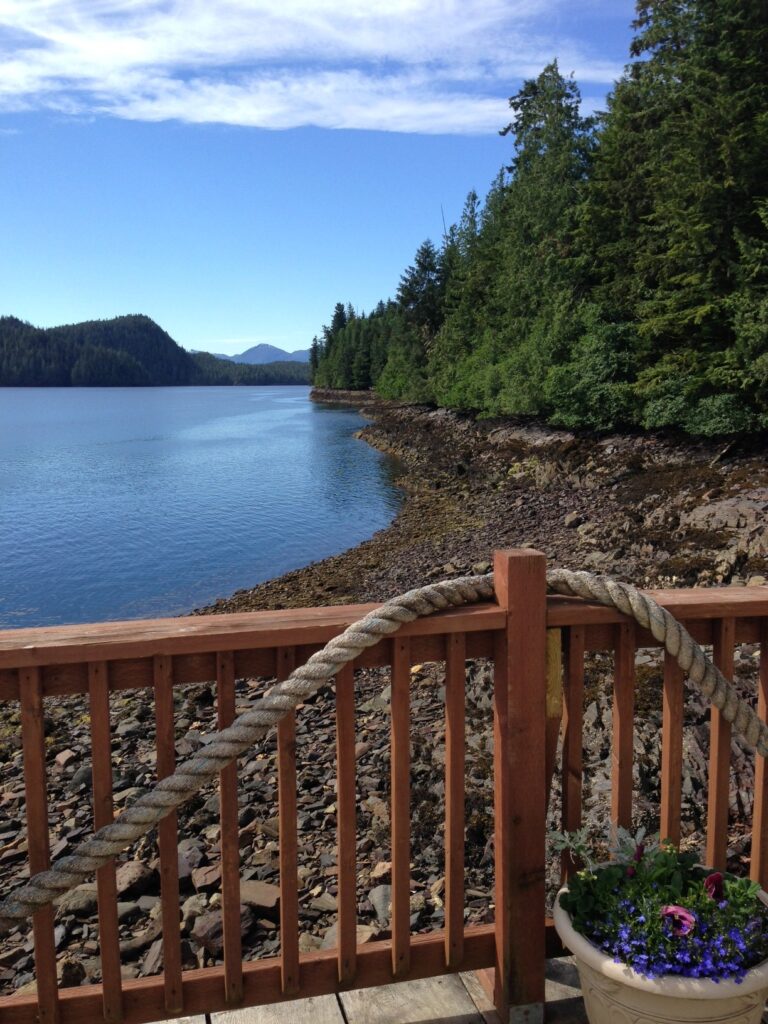‘Welcome to Ketchikan! Alaska’s first city! Population is 8,400 souls and yet we have 34 jewellery stores for y’all.’, said Bob, our bus driver, this morning. Today, Aunty Mary went snorkelling in the stupidly cold 50-60 degrees waters of the North Pacific and I went to Tongass National Park which is apparently some 14 million square miles, making it one of the largest, if not the largest, national park in the US. Bob was very droll and full of fun facts.
Ketchikan has an average annual rainfall over 162″ – that’s INCHES! But an average snowfall of only 34″. There’s a saying up here, that if you can’t see Deer Mountain (the mountain which provides a beautiful back drop for the town of Ketchikan), then it’s raining… if you can see it, it’s going to be raining soon. A lot of the town of Ketchikan was built during the gold rush of the late 1800s, however not a lot of gold was found here at that time and many of the claimers sold off their claim to residential properties pretty quickly on and moved further north. A goodly portion of Ketchikan’s shopping district on Creek Street is built over a largish creek that is actually a waterway that the salmon rushes when the season starts in a few weeks. They get five types of salmon coming into the area to spawn and you can see them in their thousands all suddenly turning up, but we were a little early for that.
Dolly’s Place in the picture is an old brothel founded by a famous local prostitute who stayed working in Creek Street running a place until her death in 1977… back in the good old days there was a path leading to the red light district (which is now paved) but once a telltale muddy path literally named, ‘Married Man’s Trail’. This well known local track apparently led to many married men coming home with muddy trousers or boots only to find themselves being accused of going off to the whorehouse and not being at work! (Like I said, Bob was full of local flavour!).
Many of the homes here are high on the hills, with long long staircase leading up to their front doors… according to our erudite guide, if you have 100 or more steps from the road to your house, the City of Ketchican is obliged to name your steps an official City lane. After which point the staircases then become under the city’s jurisdiction for maintenance and even the city’s responsibility for clearing your steps of snow because it’s an official City street. As you can imagine, there are many homes with staircases that switchback on themselves to squeeze in an extra step here or there to hit the magic 100 that means the City is responsible for them. 🙂
Anyway, we got out to Tongass National Park and did a nature hike through the estuary area. I found out lots of things about plants that we had been commonly encountering in Canada – for example, the skunk cabbage that we saw in Revelstoke National Park is a very ancient plant and apparently very malodorous (not that we noticed it back in Revelstoke?). It’s atrocious stench was evolutionarily beneficial as it would attract flies that carried out the pollination in a period before bees were prevalent to do this (bees being attracted to sweet and sugary plants). Additionally, I found out that bears eat the roots of the skunk cabbage as it works like a natural laxative for them – when bears hibernate, they deliberately consume lots of bark and non digestible crap to plug up their gut and stop their bowels from working while they hibernate, so when they reemerge in the summer, they hit the skunk weed roots and it gets them going again!
I also learned today, that when female bears are in season they will mate with numerous other bears and carry around several fertilized embryos until it’s time to hibernate. If the momma bear has the required 35% additional body weight to sustain hibernation, pregnancy and birth, the embryos will survive and grow into cubs – usually two or three cubs is quite common. The cubs will be born during the hibernation period and be about the size of a large mouse, growing to be the size of small dogs by the time they emerge in the spring. If however, the female bear does not have enough fat reserves to achieve this, any embryos she may be carrying will spontaneously abort! Fascinating stuff… but I digress.
Where was I? Oh yes, Skunk Cabbage and Western Red Cedar etc. The First Nation people (which is what the indigenous peoples up in Alaska prefer to be known as) call the Wester Red Cedar, the Tree of Life because they use it for literally everything. The timber is used for building, making homes, canoes, clan houses etc. The bark is used to strip and make woven baskets, mats, hats and what have you. The cedar also attracts a lot of moss that grows on the lower branches that grow in the darkness of the rainforest which creates a symbiotic relationship. As the trees grow larger and taller, the lower branches receive less and less sunlight which means they end up with fewer leaves on them and become a drain on the trees resources. The heavy coats of mosses that grow on these barren lower leaves can become heavy with water during heavy storms, causing these now parasitic lower branches to be automatically pruned off. Very clever.
We also learned about a plant called Devil’s Club, which is apparently far more toxic that your average poison oak or poison ivy (for whatever that is worth to your average travelling Aussie!) as it will leave you itching and burning for days after coming into contact with it. It is also covered in tiny brittle spikes, which if they get embedded in your skin are nigh on impossible to remove because they keep breaking off they are so brittle. Additionally they are covered in bacteria and cause infection pretty damn quick. So we got told to stay the hell away from that stuff and strangely enough – every one did what they were told.
The other thing they told us about the Devil’s Club was that they have found pharmazoological (much like the skunk weed and its natural laxative thing) properties that scientists are currently pursuing as a potential cure for diabetes. Cool, huh. We also discovered lots about all the berries that grow naturally in this area – blueberries, raspberries, huckleberries and something called salmon berries (yeah, I didn’t ask). Salmon berries look a bit like raspberries and range in colour from bright red to orangey yellows… and they taste like a cross between raspberries and watermelons! Very cool. People round here just pick ’em and eat ’em where they find them because apparently they just will not preserve. We were told you can’t even freeze dry them and expect them to last the trip to Seattle, they’ll have rotted by then. Go figure.
A little further into our nature tour we came out into a clearing which is an area of the estuary that has a salmon hatchery… the hatchery has some artificial salmon ladders which attract the salmon up into the hatchery, at which point the salmon are trapped. They will spawn in the hatchery which allows fingerlings to be bred that are then released in areas that are being repopulated with salmon. This whole salmon hatchery area does three things:
- helps out the salmon industry
- provides somewhere for the local bears to catch a quick feed and
- attracts hundreds of bald eagles.
We only saw one bear on our little hike, but as we wandered around, my fancy new lens paid for itself yet again as I took some awesome shots of these incredible birds! I had come out this morning hoping to see a bald eagle, but never dreamed I’d see over thirty of them! Lots of skittish juveniles, as well as plenty of mature birds that were quite happy to sit and let you get fairly close to them. I even managed to get some photos of them in mid-air with their 8′ wingspan fully extended. These eagles are enormous, much larger than the wedge tail eagles I have seen at home, and so distinctive with their white heads and yellow beaks.
There are approximately 30,000 bald eagles in Alaska so there is no conservation program or even a counting program for them as they have always been plentiful up here, compared to the lower US states where bald eagles have become endangered in some areas. We saw this one up close in a raptor enclosure because she unfortunately can’t be released to the wild any more, but I took lots of photographs of the wild ones outside. We also saw a Great Horned Owl that was in a similar boat – rehabilitated from injury but unable to be released. After that we went to feed some reindeer. Apparently reindeer are completely domesticated and raised for their antler velveteen and their meat – there’s a reindeer sausage factory in town somewhere, so we might have to try some of that if we come across it on a menu somewhere.
Part of our tour also took in an old timber mill from the early 1900s in the area and all their old equipment, as well as a visit to a totem pole carver, named Wayne who happened to be working on some commissions for the Alaskan Wildlife Sanctuary (that we had just come through) that were to be 12′ long totems of the various salmon that come to the area – five totems in all, and he was working on the King Salmon totem while we were there. He showed us the tools of his craft and we learned later from Bob, that your ‘average totem costs about $3,000… per foot! So a regular sized totem can cost up to $85,000. Holy shit! I mean they’re cool and all, but not that cool!
After that we headed down the the George Inlet lodge where we were provided with a full all you can eat Alaskan crab feast, caught on some of the ships that you see in that TV show, ‘Deadliest Catch’. It was a beautiful spot on a gorgeous day (yep, we were fortunate enough to see the top of Deer Mt when we came into town so it was not, at present, raining 😛 ). Our wait staff were all wearing waders, which I thought was really odd until Holly and Mac proceeded to give a lesson to those crab eating novices among the crowd (and strangely, there was plenty of them), on how to go about eating their crab. Water and crab juice and shell went flying everywhere as they demonstrated the best way to get into the crabmeat. I though, great… I’m going to have to go do laundry tonight as I only have one decent jumper with me! Turns out, the only people in the room who could get into their crab with any skill or decorum were a couple of guys from Florida, some people from lobster country in Maine and one other Aussie and myself! Everyone else got covered in crab and made a huge mess, causing lots of laughter and more than a few exclamations of ‘Oh shit!’ to ring across the room. 😛 It was all you could eat so I had about half a largish crab, seeing we had skipped breakfast, and that was plenty for me, but there was a guy at the next table who must have put away two whole crabs, complete with heaps of hot butter sauce to dip it in! Turns out last tourist season (May to September) they served up over 33,000lbs of local crab at this one restaurant. I keep telling Aunty Mary that, the local cuisine is a big part of the travel experience, but she won’t believe me! 🙂





